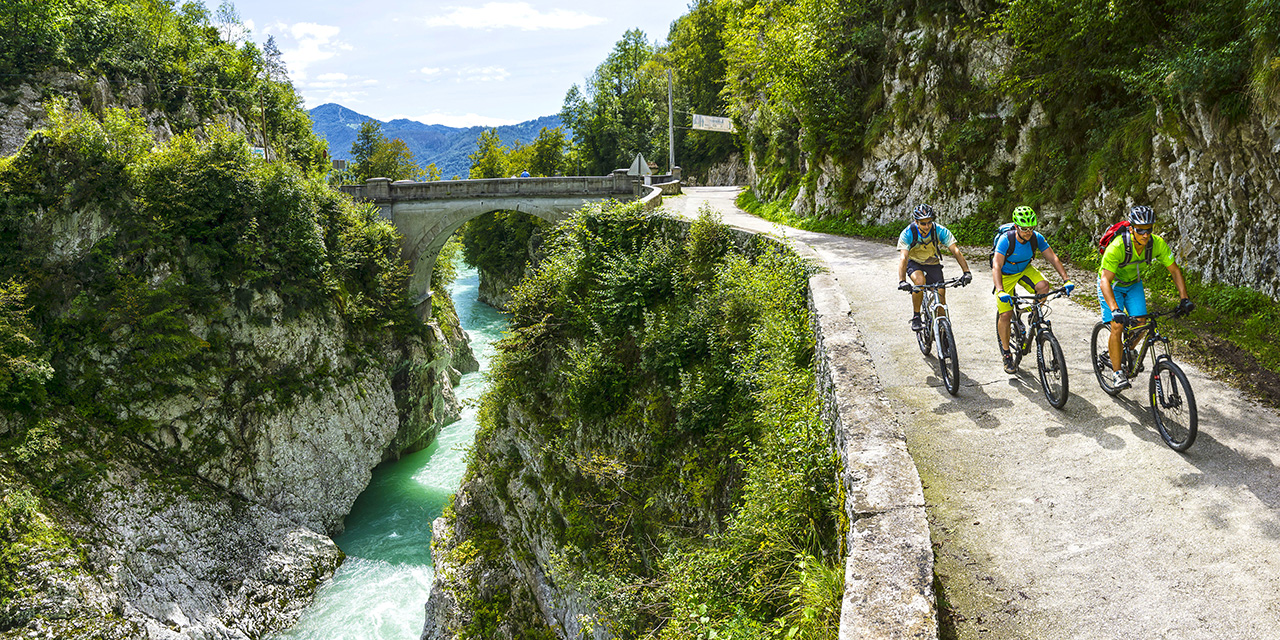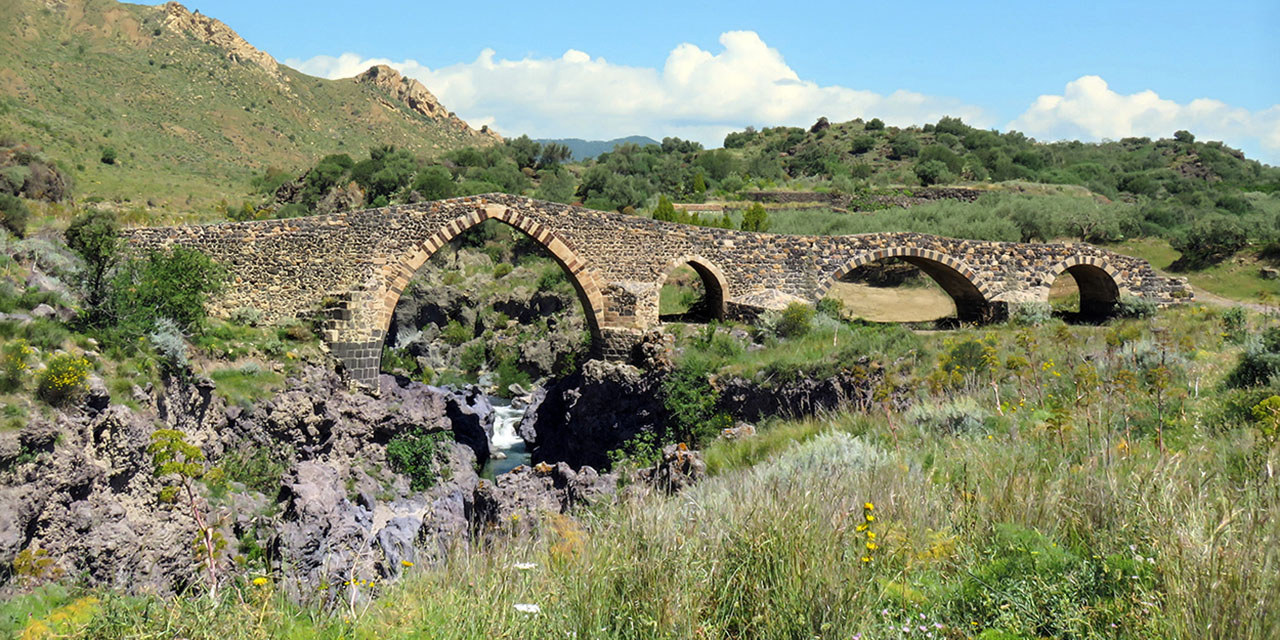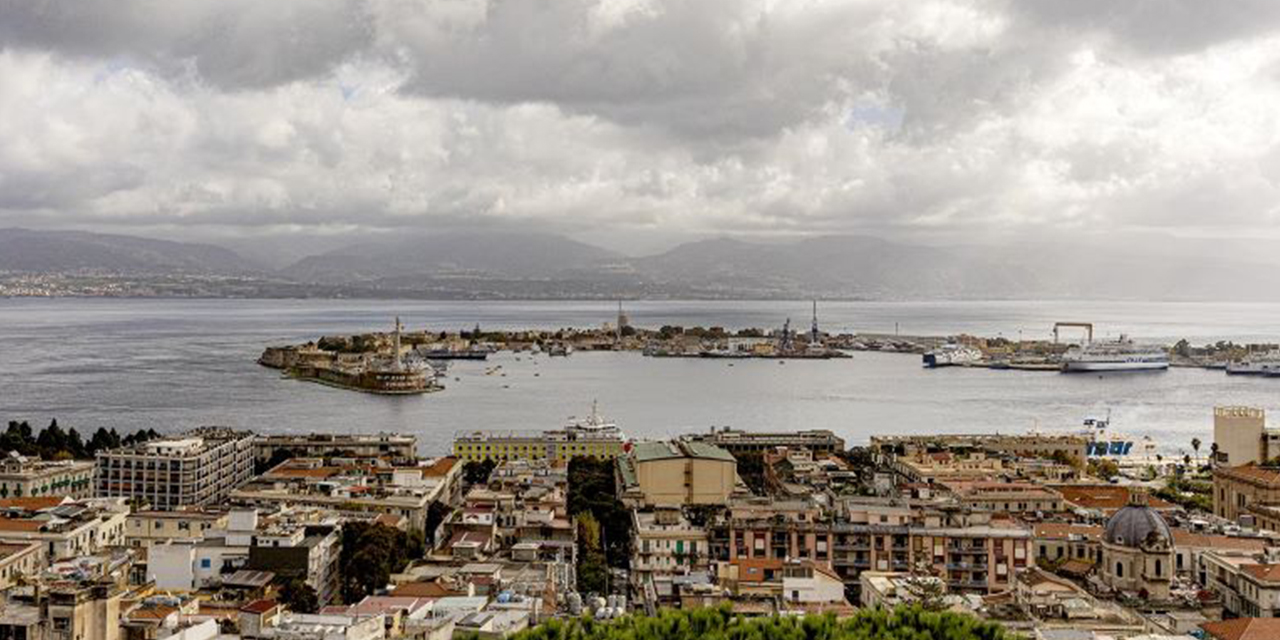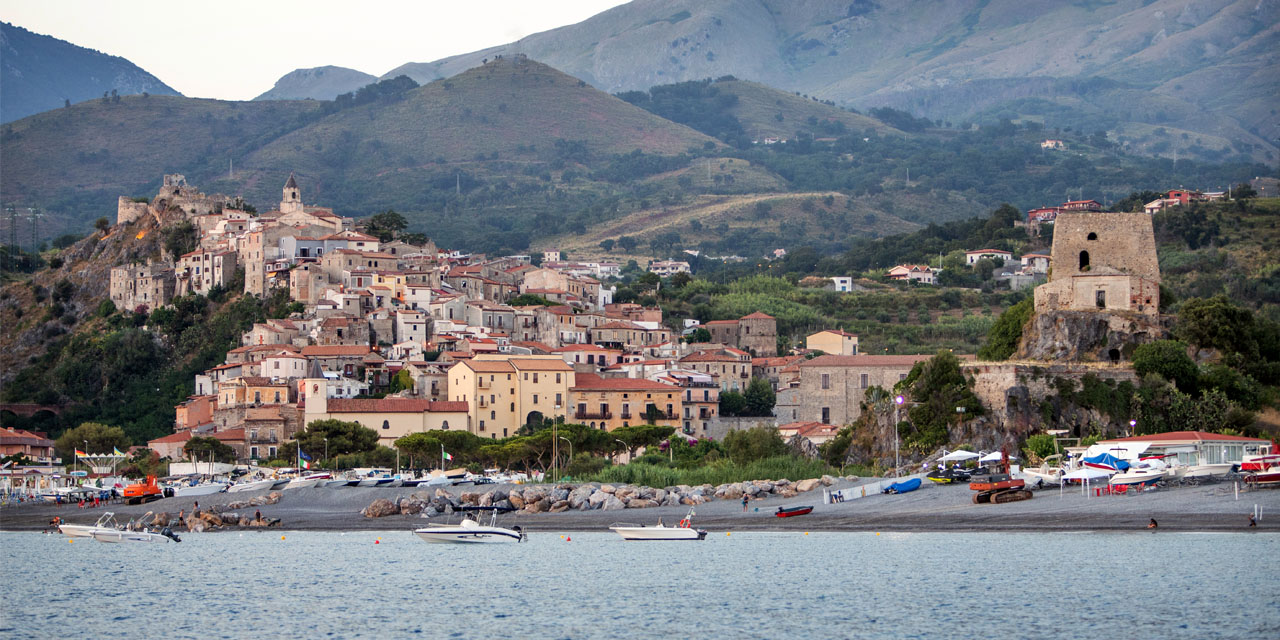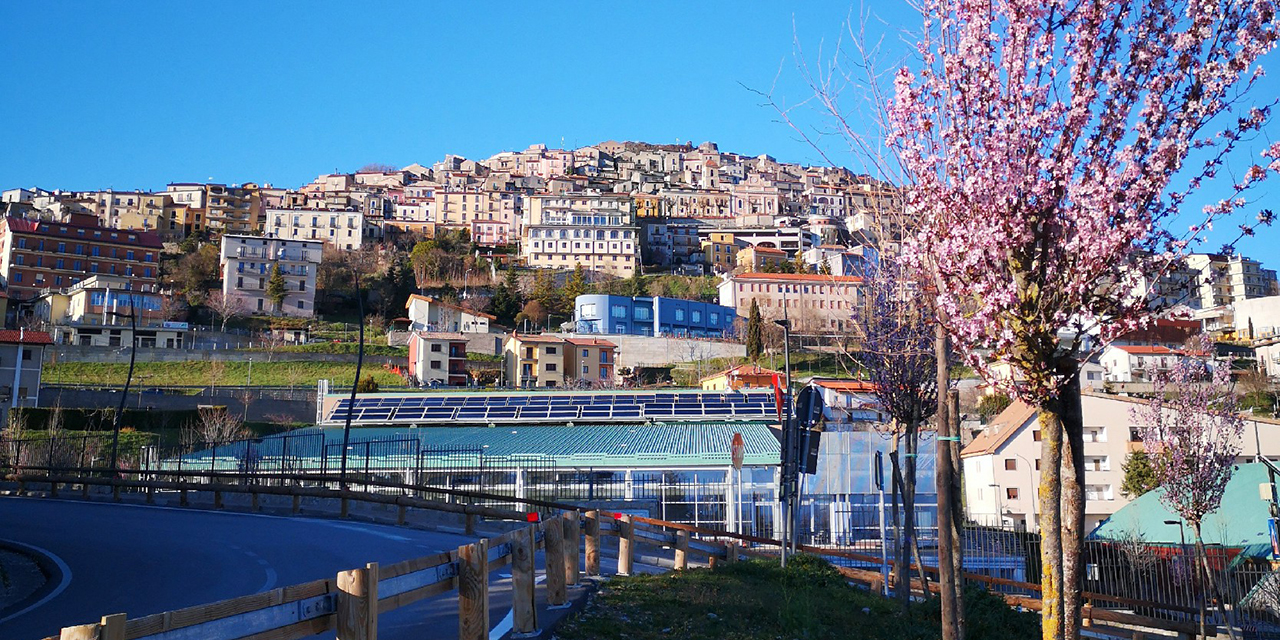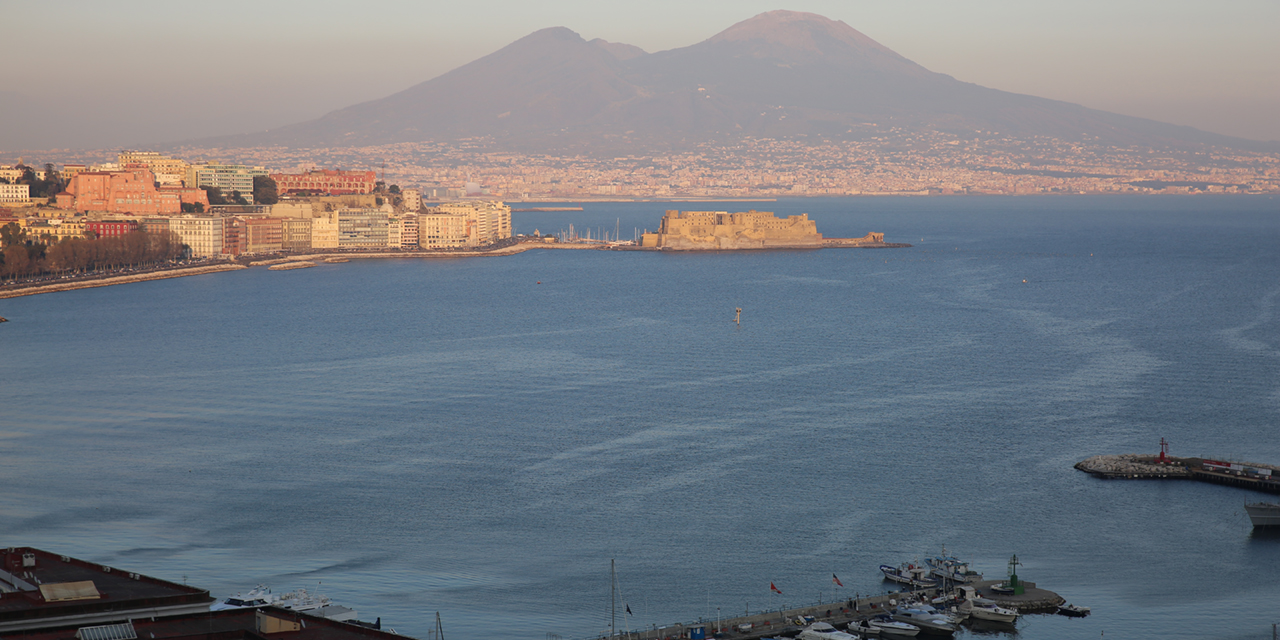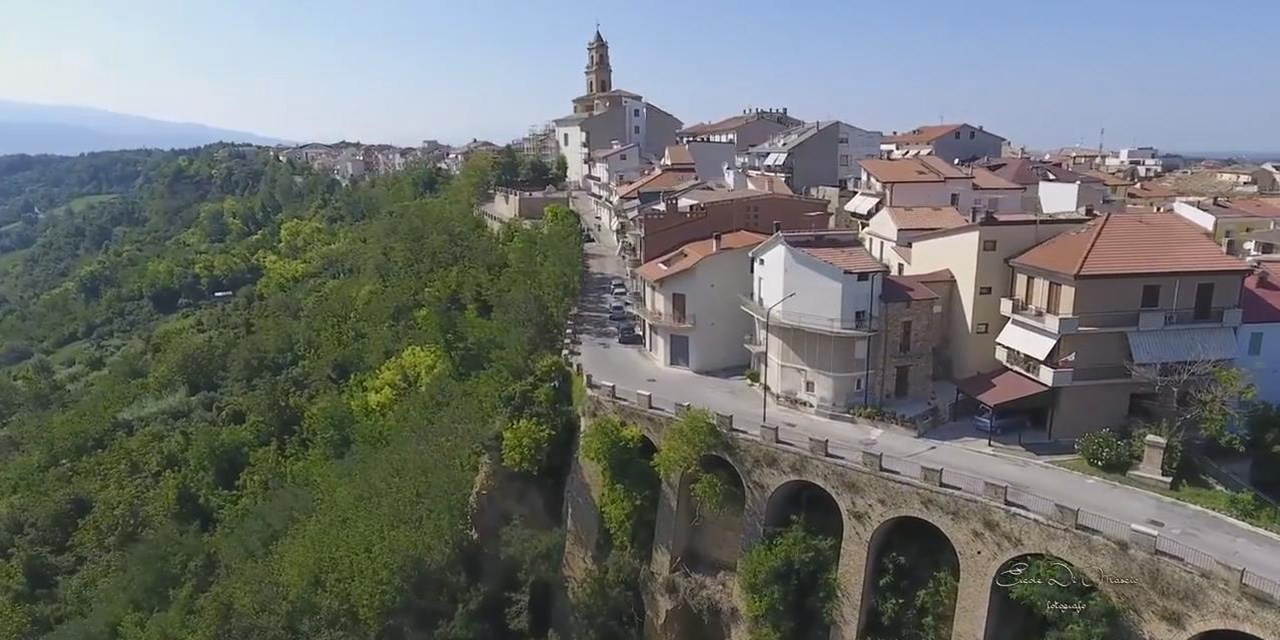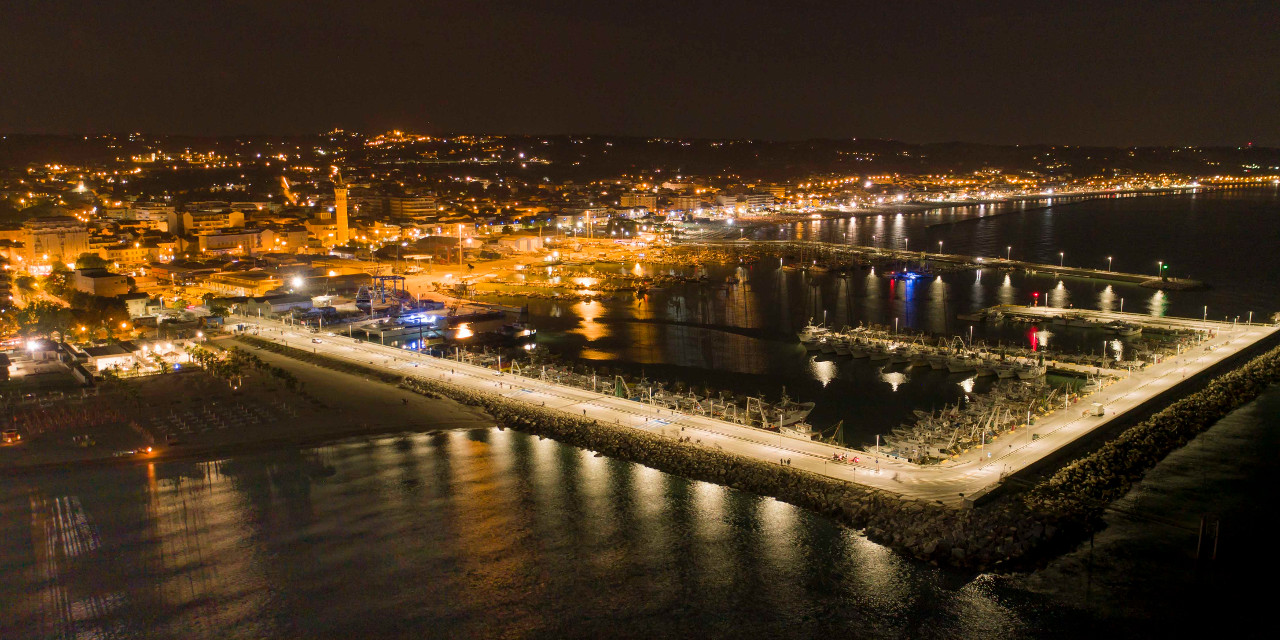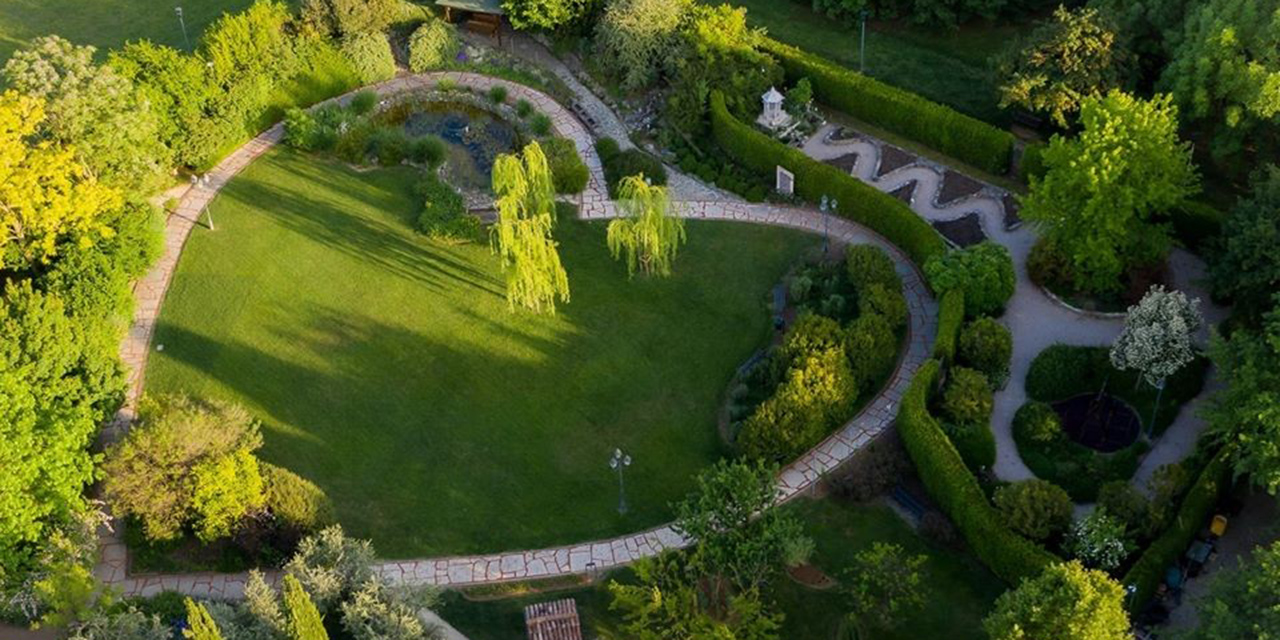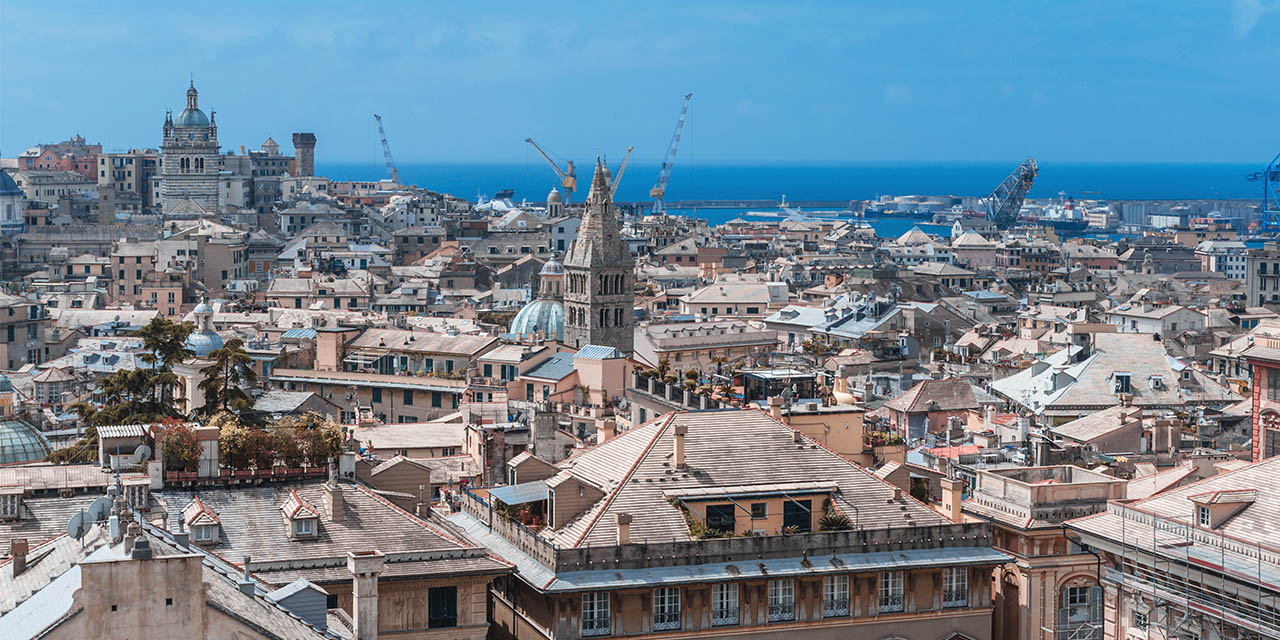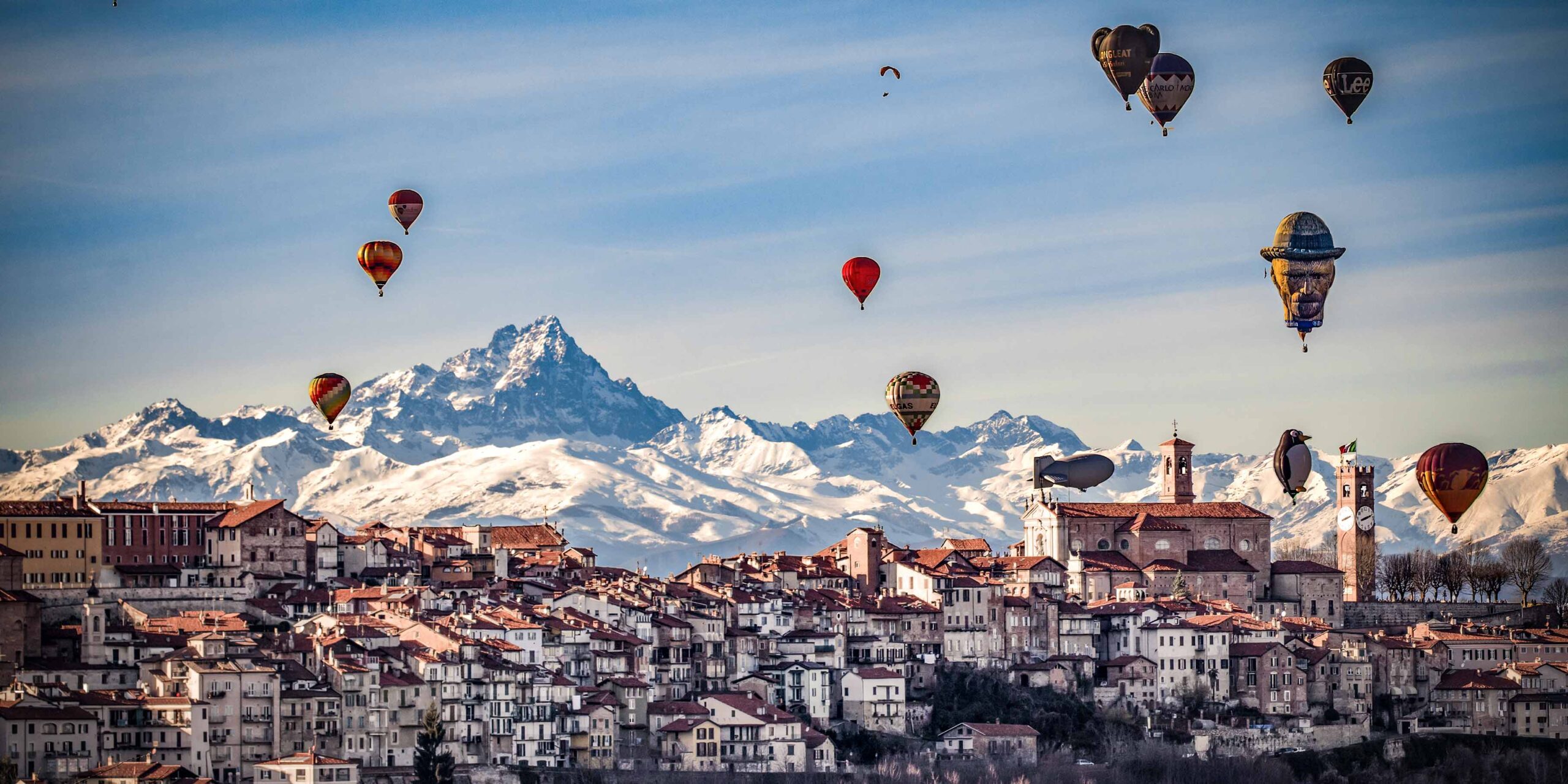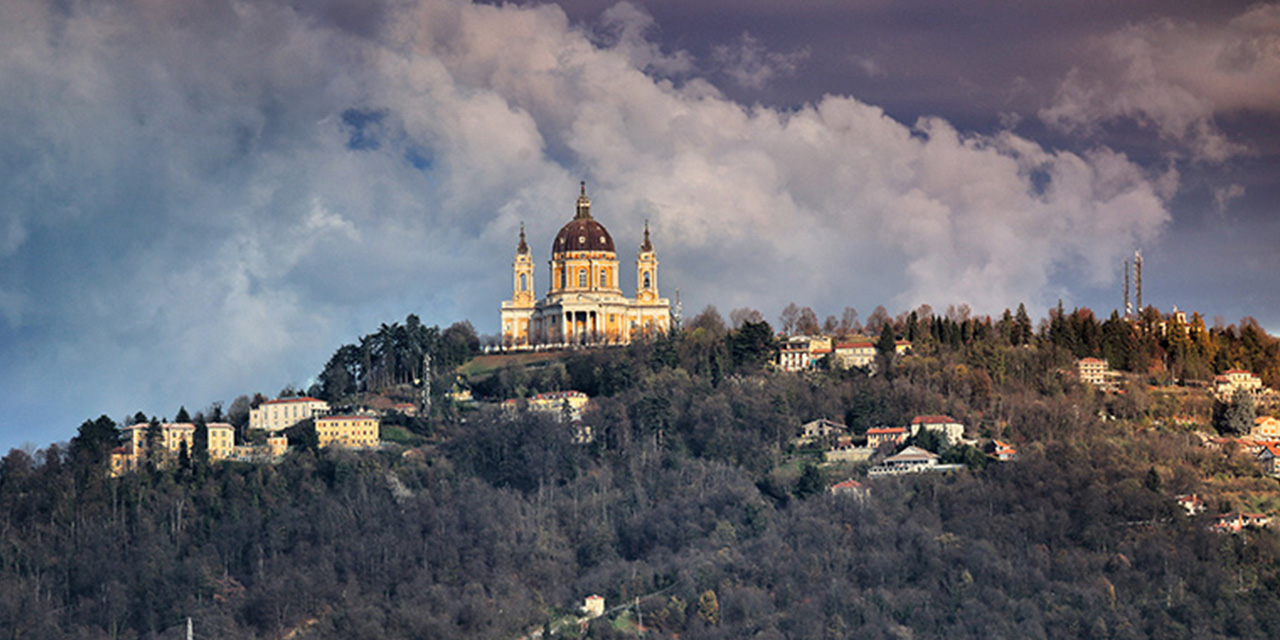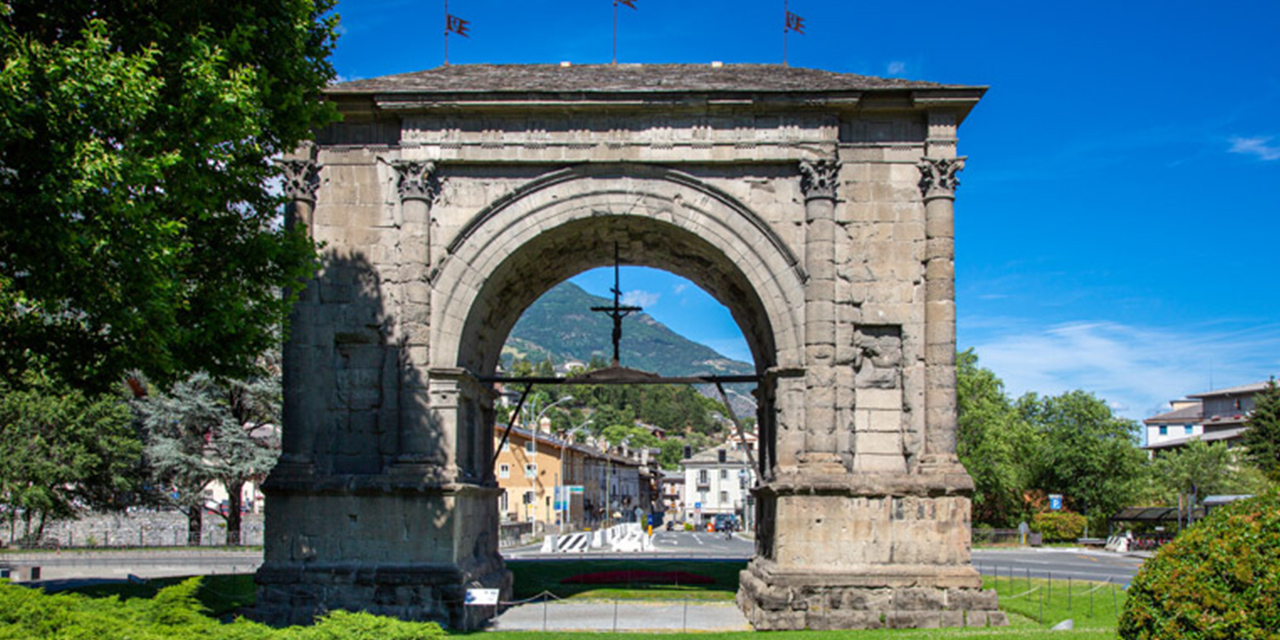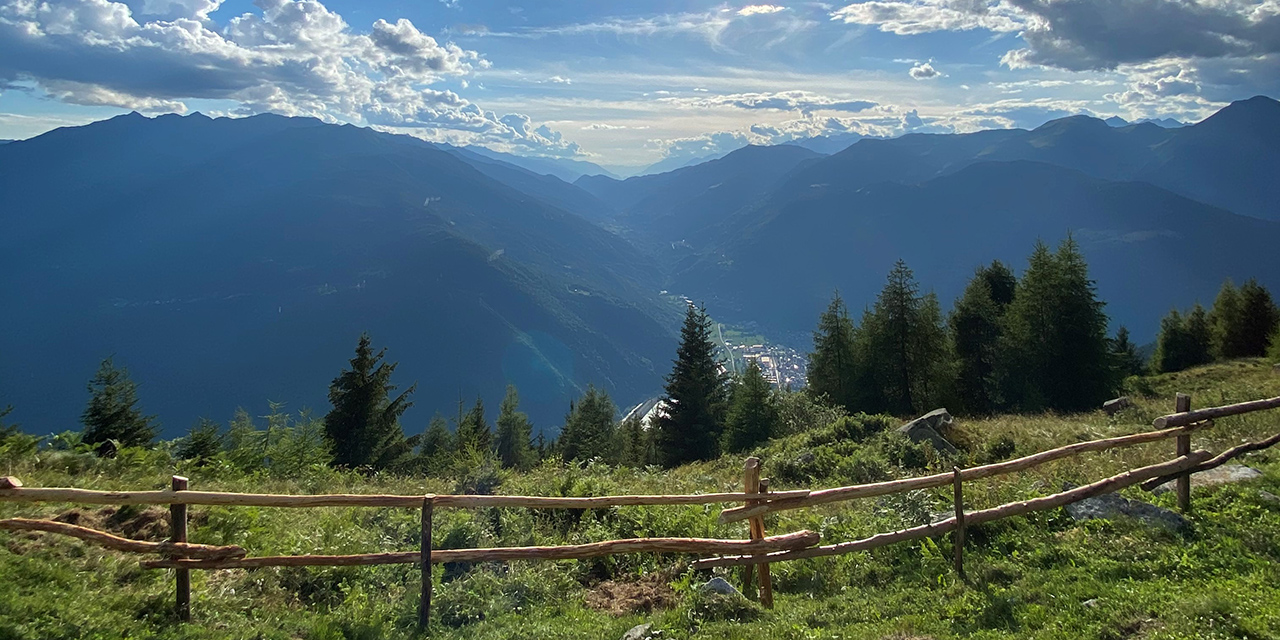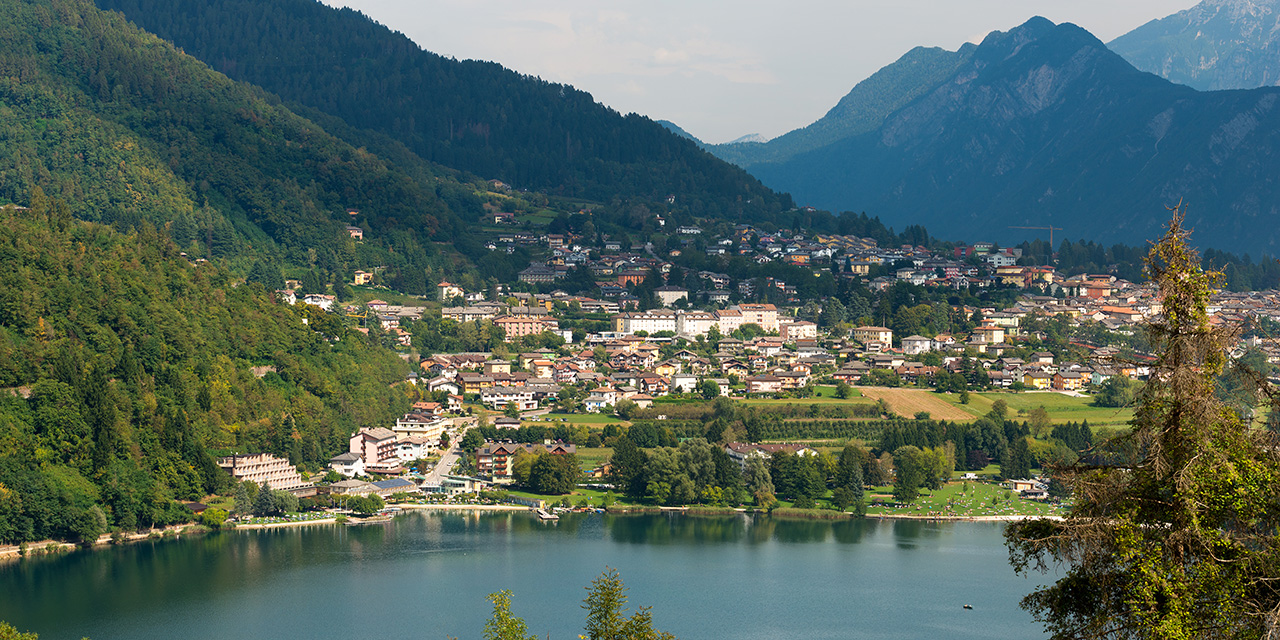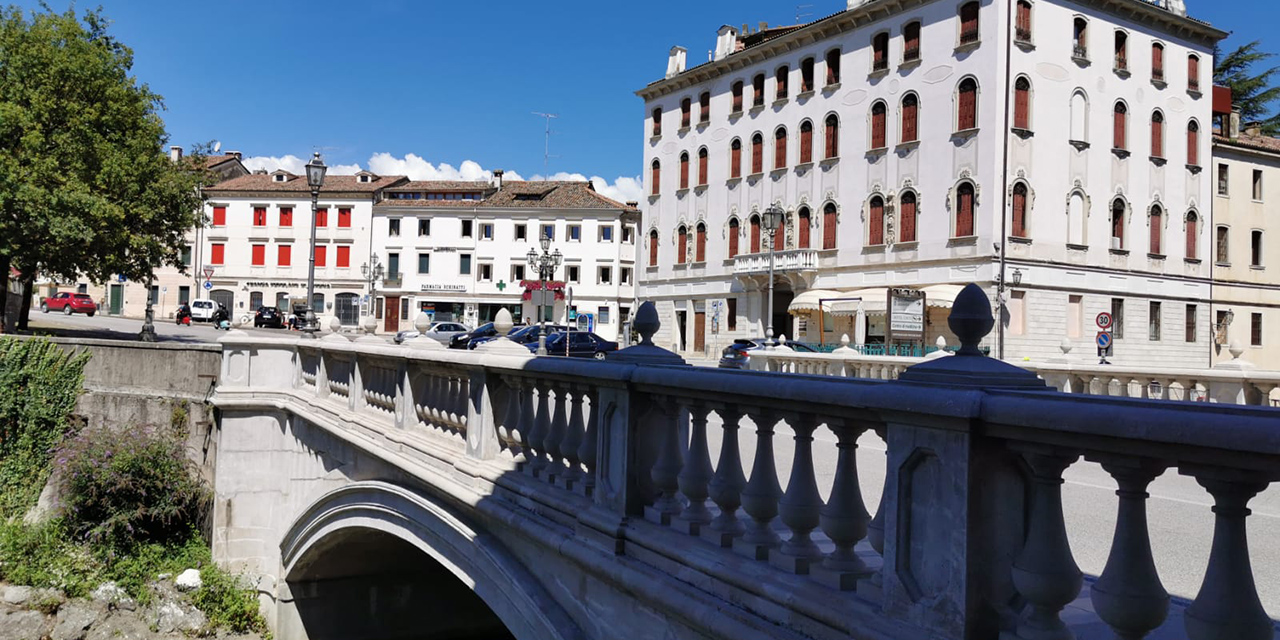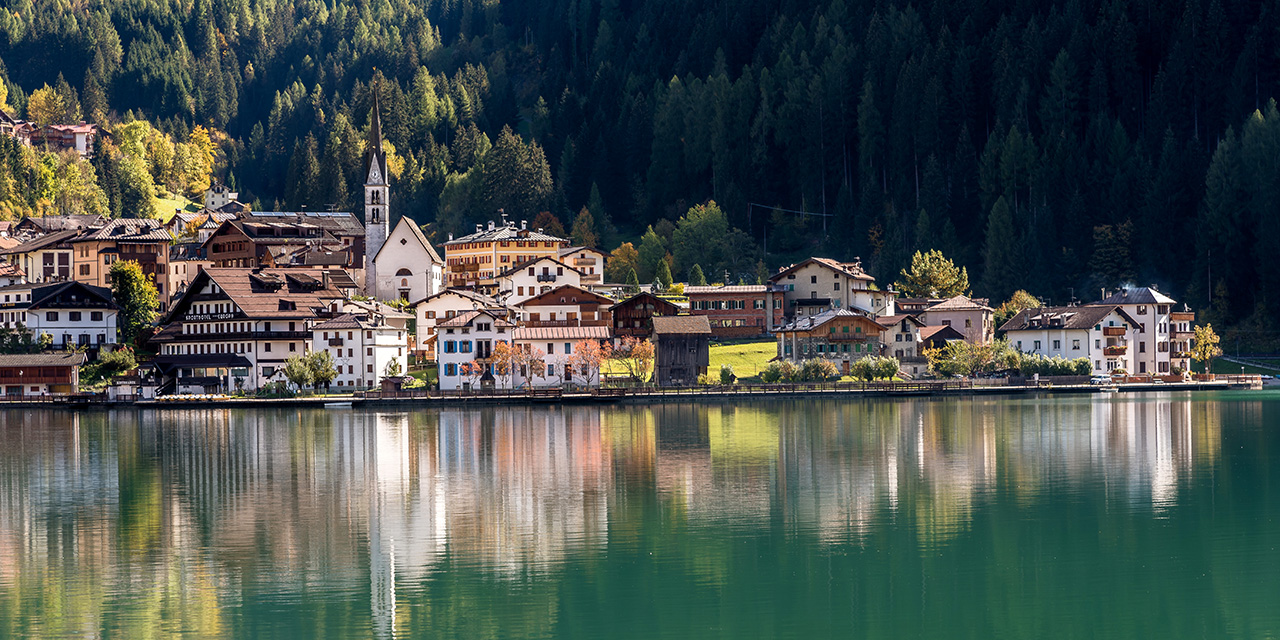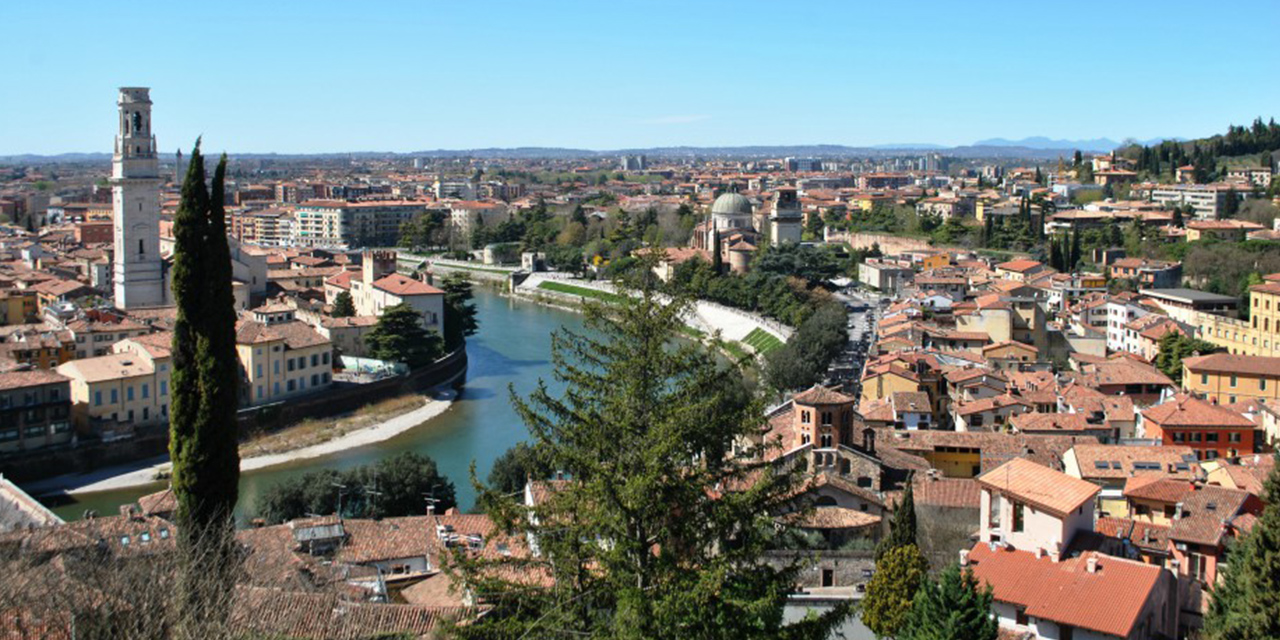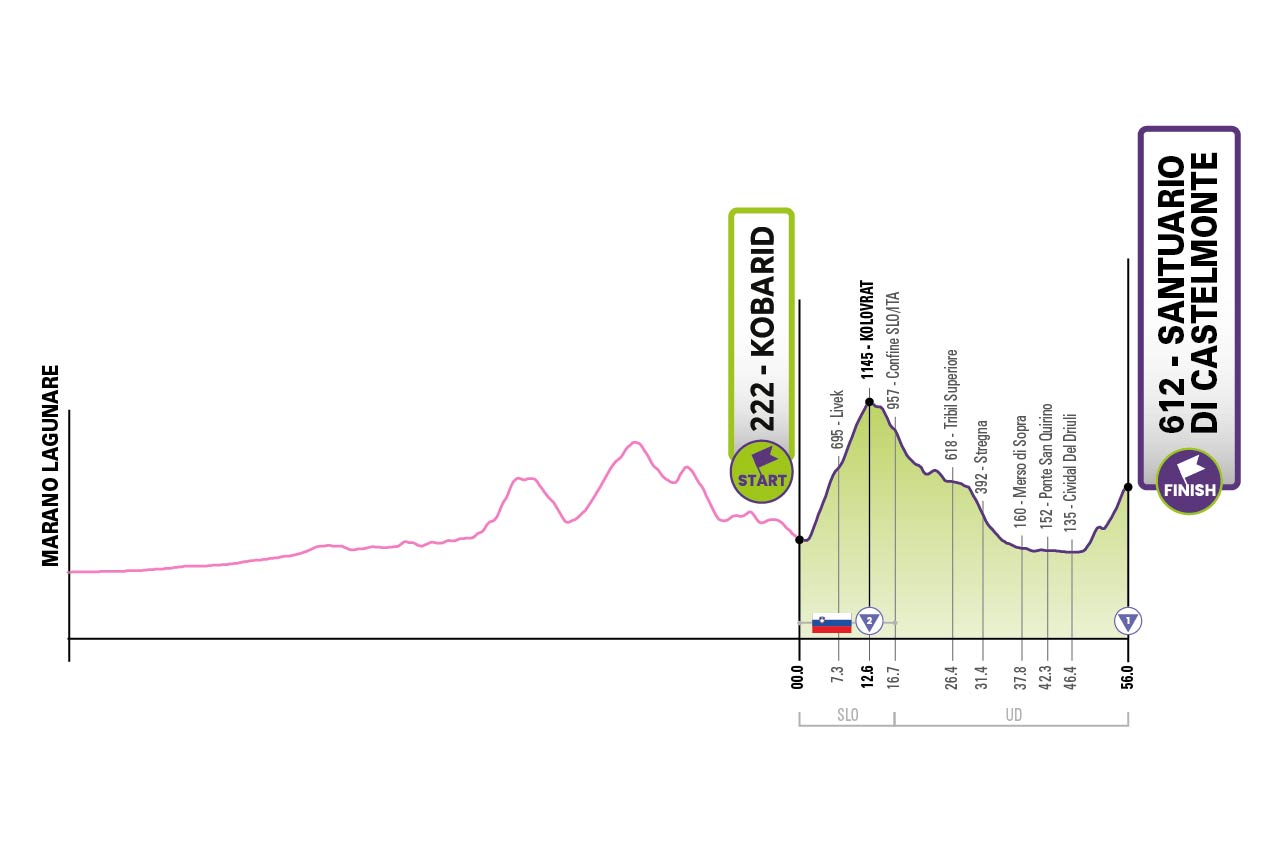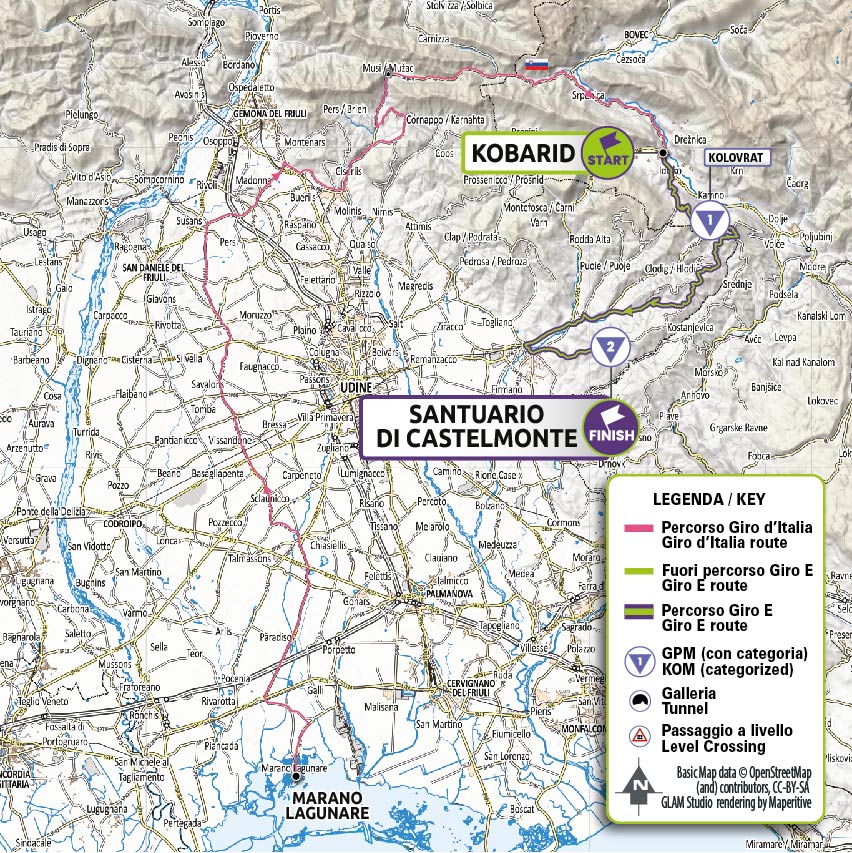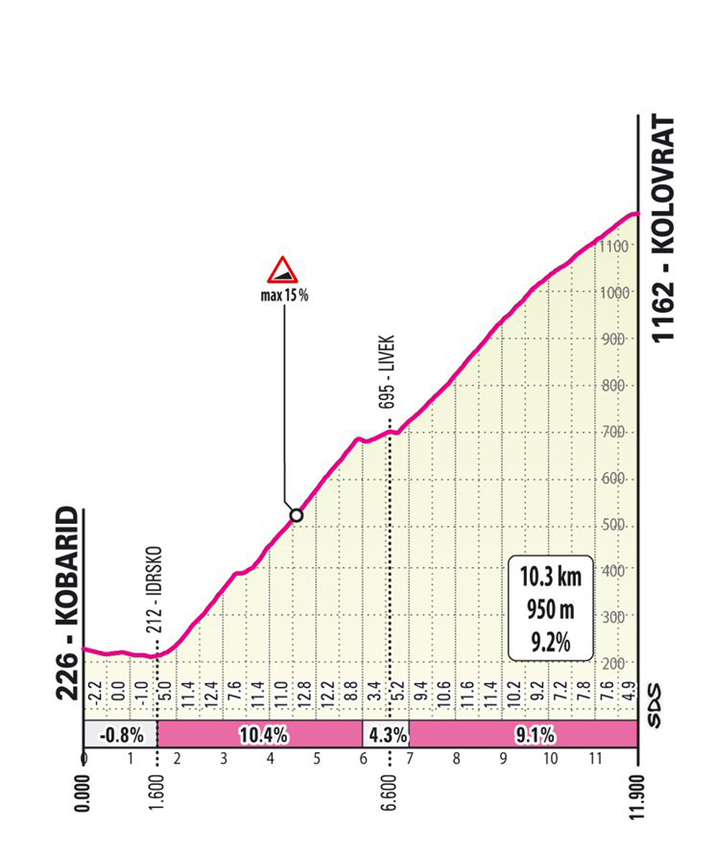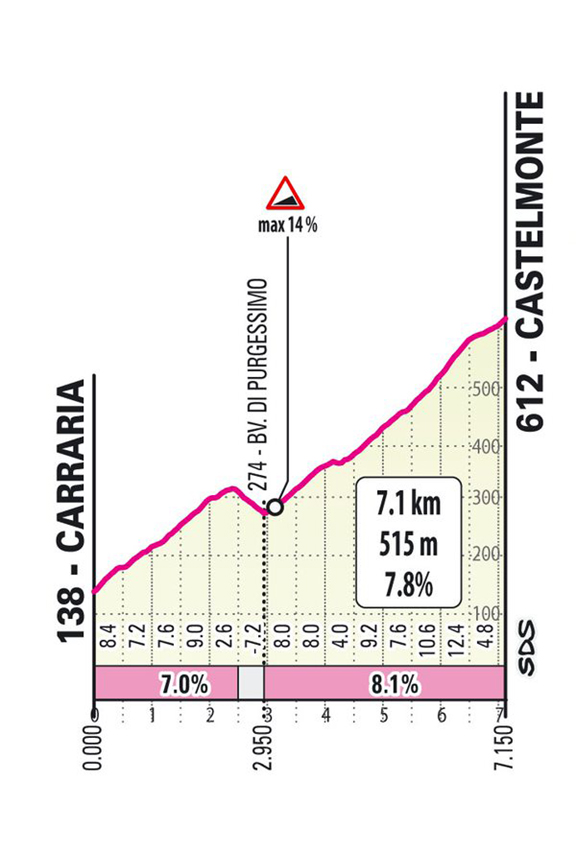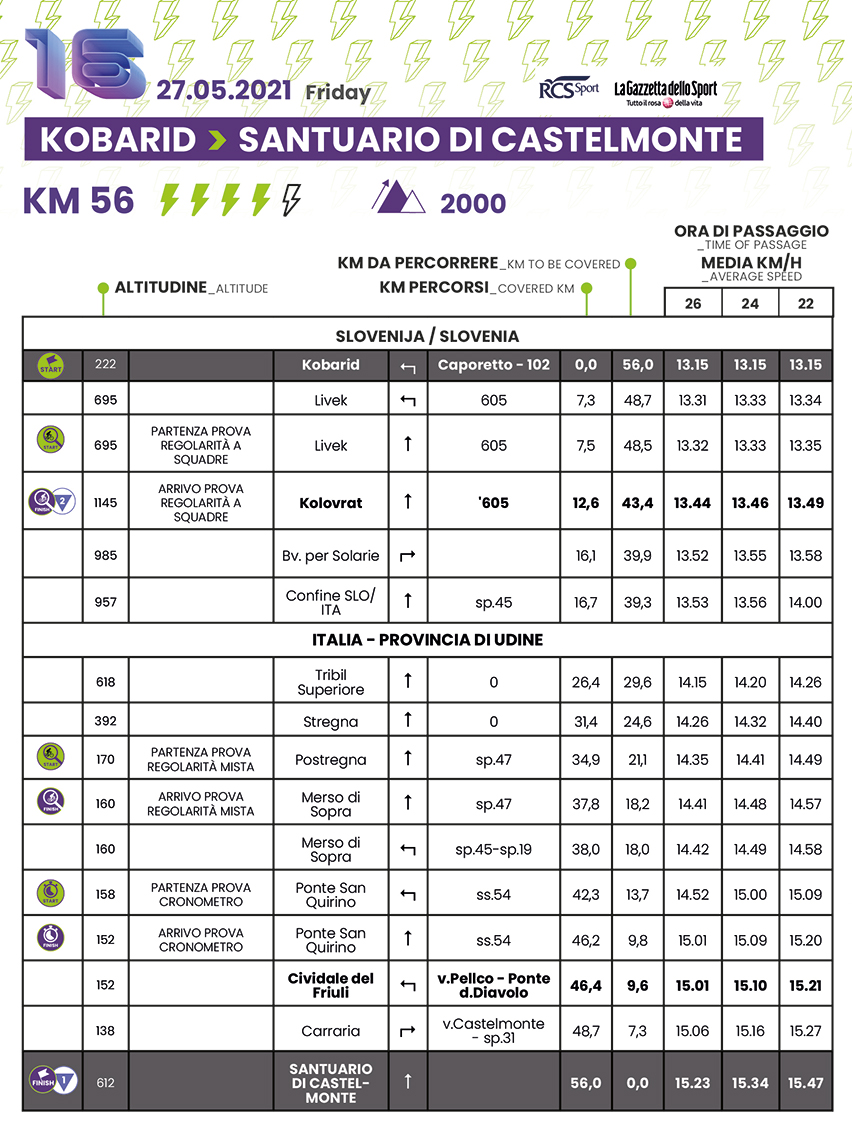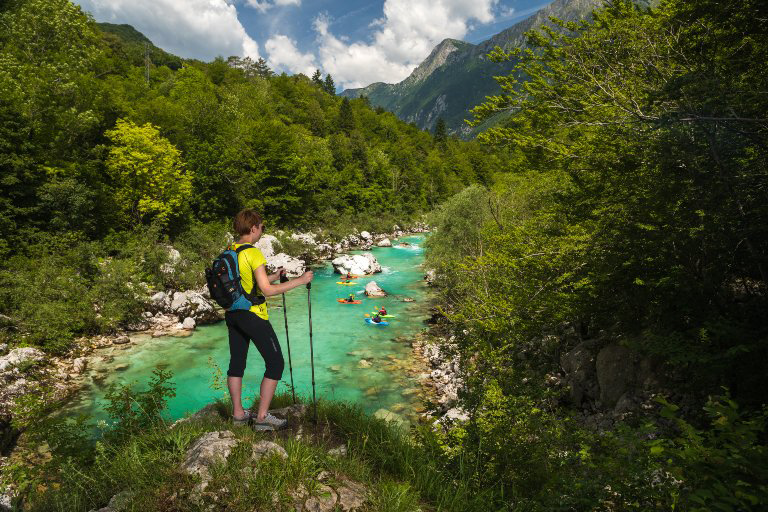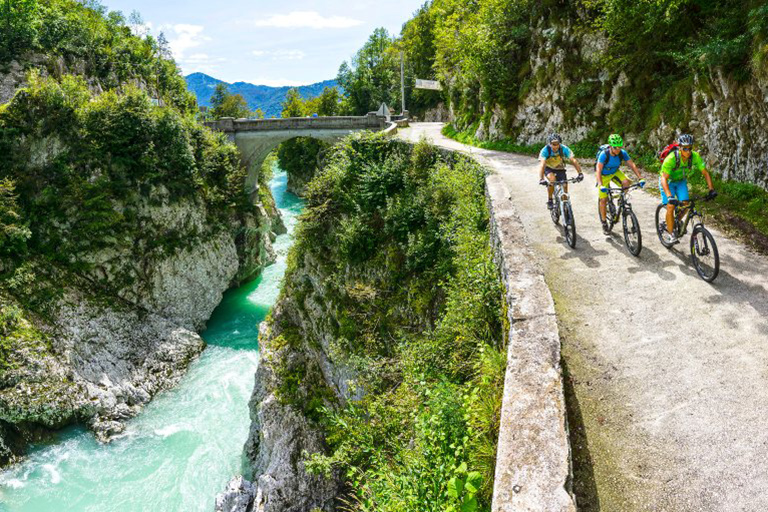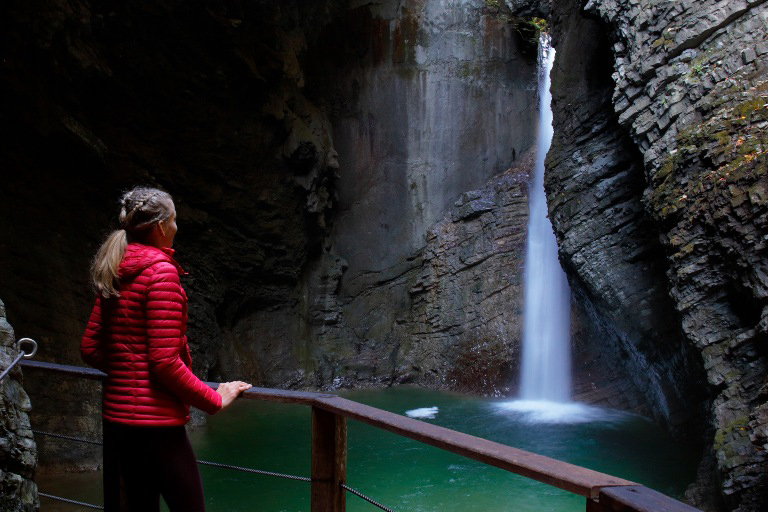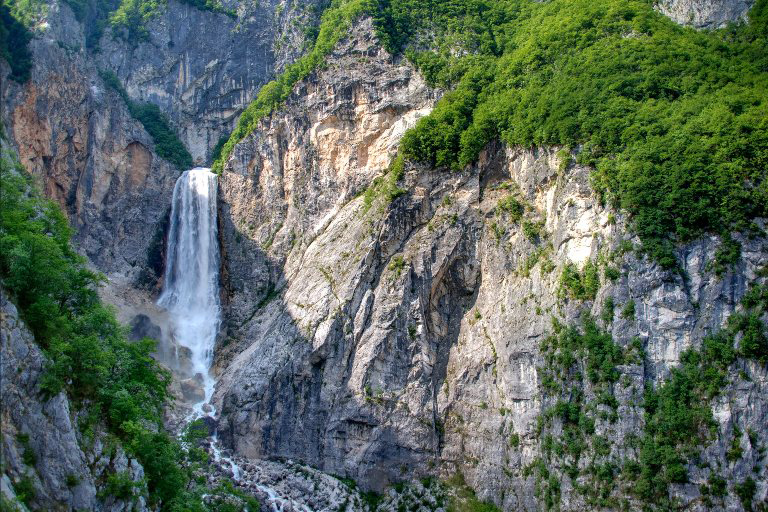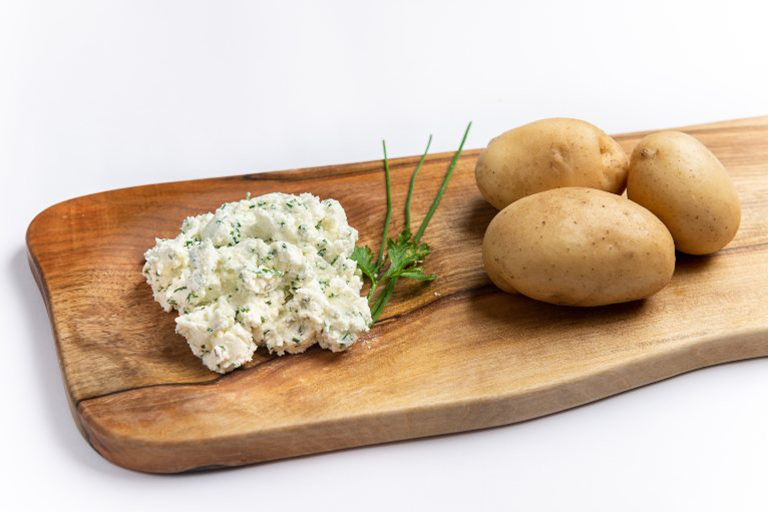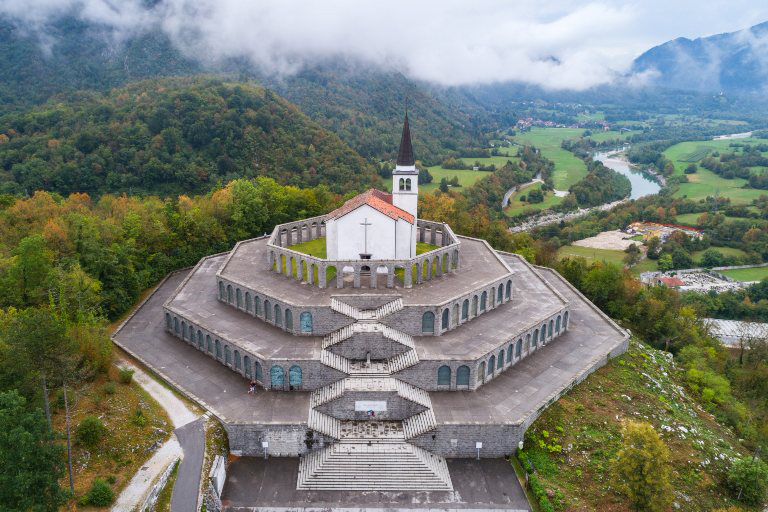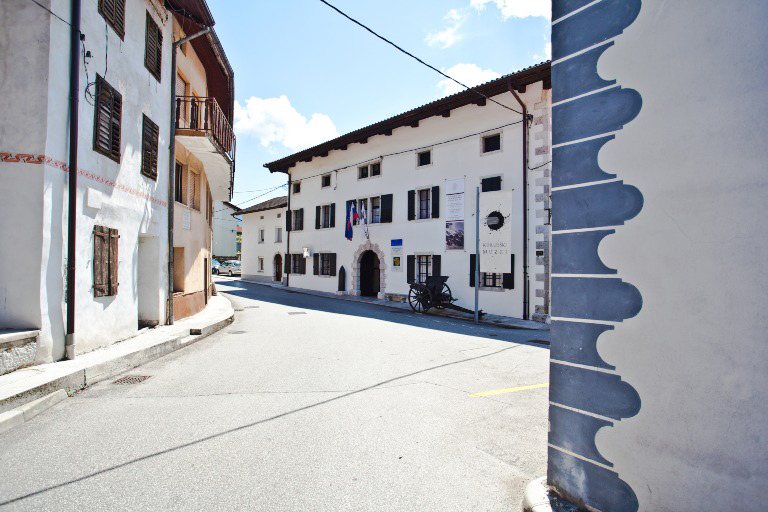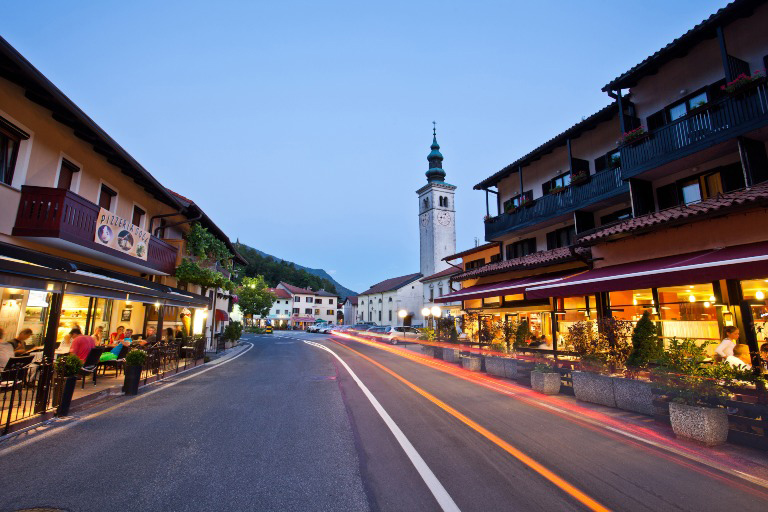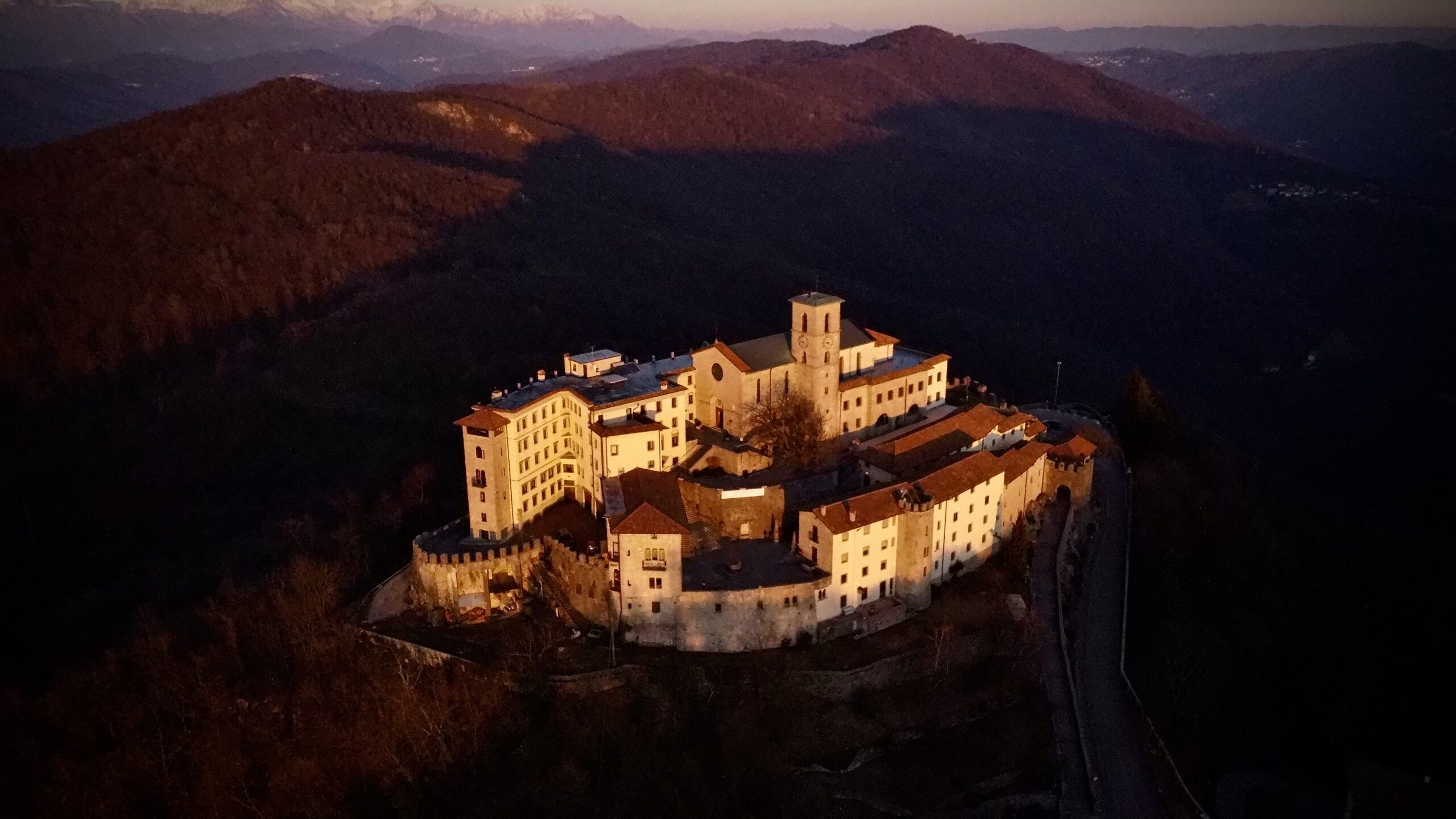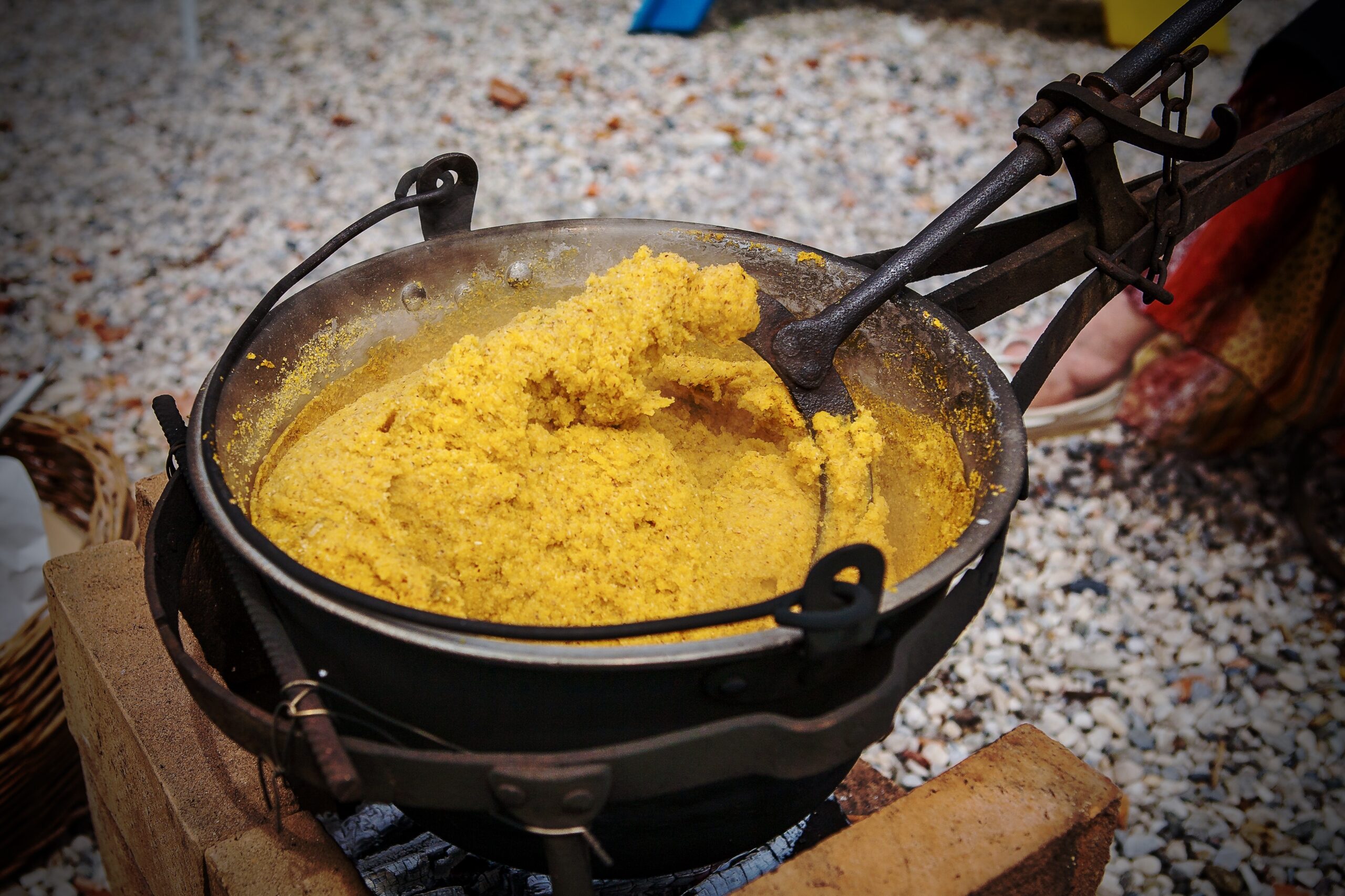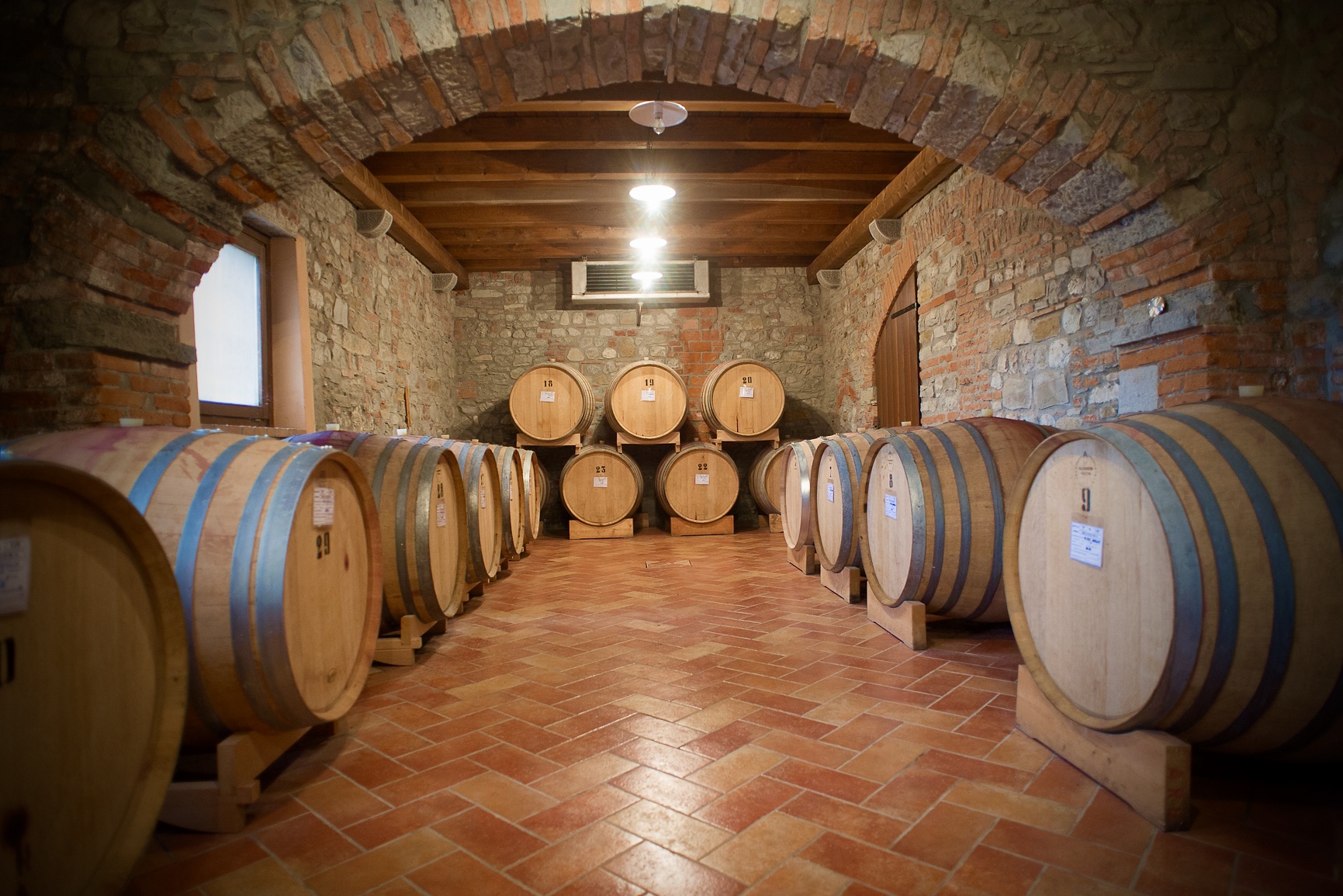profile
map
climb detail
itinerary timetable
tourist info
Host city:
KOBARID
Touristic information
The Slovenian territory that borders with Italy, also called the Soča Valley, includes three major towns: Bovec, Kobarid and Tolmin. Kobarid is a small historic town below the mighty mount Krn and the scene of heavy battles on the Isonzo Front. There are many historical sights that tell the story of the Isonzo Front: Kobarid Museum, Italian Ossuary, Memorial church of Javorca, outdoor museums, numerous cemeteries, chapels etc. All these sights are connected by the long-distance Walk of Peace from the Alps to the Adriatic. The Soča Valley is known for its beautiful unspoiled nature, numerous waterfalls (Kozjak, Boka, Virje), gorges (the Tolmin Gorge) and the emerald Soča river. It is also a paradise for many sports activities; there are many hiking and biking trails, water sports and fishing are popular along the Soča River, while paragliders take up their space in the air.
Gastronomy
In Soča Valley, the significance of traditional food has been very important already in the past. The gastronomic tradition has been passed down from generation to generation, both in written and oral form, especially the cheese-making tradition. Only a few can resist the smells of local cuisine and renown culinary delicacies such as potatoes with cottage cheese, frika (potato cheese omelette), trout, delicious local desserts “Kobariški štruklji” (sweet dumplings with walnuts and raisins) and “Bovški krafi” (sweet pockets with pears and walnut filling), and for centuries appreciated cheeses with a protected origin – Tolminc cheese and Bovec cheese.
However, the cuisine of Soča Valley is anything but simple and plain. In Soča Valley, local tradition is transformed into top gastronomy. Many excellent restaurants and inns with a long family tradition are developing modern flavors and thus elevating the local cuisine to a higher level. The highlight of the local gastronomy is presented by Hiša Franko restaurant, where Ana Roš, named The World’s Best Female Chef in 2017, creates her original and creative dishes, while the restaurant itself has held the title of one of the best restaurants in the world for several years. It is the only restaurant in Slovenia with two Michelin stars.
The gastronomic offer of Soča Valley is complemented by culinary events and festivals such as Jestival, Potatoe Night, Frikafest, Soča Trout Festival.
Beverages
Soča Valley is also famous for its liqueurs, as the locals have preserved the distillery tradition very well. Native fruit varieties, mainly coming from large apple, pear and plum orchards, are the basis of local liquors. Brandy has a recognizable flower with a pleasant smell and taste. It is distilled in the traditional way in special copper boilers with caps.
Soča Valley is not a wine-growing area, however, the story of wine is nevertheless very important, as the valley is located right next to Goriška Brda region (Slovenian Collio), famous for its quality wines.
Main Sights
The Soča river
The emerald Soča is a popular destination for lovers of water adventures. In the hot summer months, the Soča river offers a pleasant refreshment, as do the much warmer rivers – the Nadiža river and the Idrijca River. The Soča river is also a fly fishing paradise. The emerald beauty and its affluents are the place where the Isonzo trout, Salmo marmoratus, reigns.
Mt. Kanin and Mt. Prestreljenik Window
The unique high-altitude karst terrain of the Kanin Mountain range includes numerous natural phenomena. You can take the trip along the natural science educational trail, while the more demanding hikers can take a tour to one of the nearby summits. Mt. Prestreljenik Window is a very popular destination which can be accessed along a marked hiking trail or along the family-friendly ferrata. During the winter you can ski on the Slovenia’s highest lying ski slope on Mt. Kanin.
Boka Waterfall
Boka Waterfall is the mightiest waterfall in Slovenia. The view of the water falling 106 meters into the valley below is quite magnificent in late spring when up to 100 m3 of water per second flows into the valley. You can observe the waterfall from the road Bovec–Kobarid, while you can visit the mouth of the waterfall along a marked trail.
Kozjak Waterfall
In the outlet mouth of the lower gorge of the Kozjak Stream, which springs high beneath Mt. Krnčica, you can find the stunningly beautiful 15-meter-high Kozjak Waterfall. Caught between the walls of some sort of an underground chamber, it falls into a large greenish blue pool. There is a neatly-arranged trail leading to the waterfall.
Kobarid Museum
This museum serves as a memory and a reminder of the events that took place on the Isonzo front during World War I. The museum pieces, large reliefs of the surrounding mountains, extensive photographic collection, reconstruction of a cavern and the documentary subtly narrate the story about the difficult and bloody period in the Soča Valley. The 12th Isonzo battle – The miracle of Kobarid – is especially highlighted because it is considered the most successful breakthrough operation of World War I.
Italian charnel house
The military monument, the only ossuary of the fallen Italian soldiers in Slovenia, was inaugurated in 1938 by Benito Mussolini. An asphalted road with the Stations of the Cross placed along, leads to the ossuary (309 m). The ossuary is built in the shape of an octagon with three concentric circles that narrow towards the top of the Church of St. Anthony. The church was built prior to the construction of the ossuary, in the 17th century. The remains of 7,014 known and unknown Italians who fought in the First World War in Soča Valley were moved to the ossuary.
Dairy Museum
The Dairy Museum of Planika Dairy factory produces its delicious dairy products according to the centuries-old tradition in the upper Soča Valley. The heritage of alpine pastures is presented with ethnological exhibits, a documentary film and a reconstructed shepherd’s hut containing all dairy equipment.
Kolovrat, outdoor museum
During the First World War, the Italian third line of defense stretched along the extraordinary panoramic ridge of Kolovrat (1115 m), which connects the Friulian Slavia region (Italy) with Soča Valley (Slovenia). Observation sites, firing trenches, machine gun artillery positions, and caverns are particularly interesting because of various details, such as the spiral staircase in one of the caverns and, in some cases, original use of materials during the war. The cross-border museum with an exceptional view over Soča Valley preserves the memory of the third line of defense of the Italian army during the Isonzo Front.
Tolmin Gorges
The wild gorges of the Tolminka and Zadlaščica rivers with the distinctive wedged rock resembling a bear’s head are the lowest entry point into the Triglav National Park and an exceptional natural sight. The confluence of these rivers is the only confluence in a gorge you can find in Slovenia.
Javorca, Memorial Church of the Holy Spirit
In the vicinity of the Polog Mountain pasture in a picturesque valley of the Tolminka River you can find the Church of the Holy Spirit – a magnificent monument of World War I. It is dedicated to the fallen Austro-Hungarian defenders of the Tolmin battlefield of the Isonzo front.
Tolmin Museum
The rich cultural heritage of the Soča Valley is concisely presented in the Tolmin Museum which is housed in the former Coronini Mansion.
SANTUARIO DI CASTELMONTE
Touristic Information
Prepotto is an Italian town with just over 700 inhabitants in Friuli-Venezia Giulia. Among the largest municipalities in the province of Udine, its 34 neighbourhoods cover a surface of 34.24 km². It borders for 15 km with Slovenia coinciding with the Judrio stream, which was the border between the Republic of Venice and Austria with the Treaty of Worms of 1521.
The borderland has a particularly interesting history, a perfect synthesis of cultures and populations that have animated this area of Friuli.
The orography of the municipal area is rather complete. Flat plains and mountainous areas alternate creating a unique landscape, rich in flora and wild fauna.
The pride of the Prepotto area is the Schioppettino, a native vine born right in the Judrio Valley that is part of the Ribolla family. This small town famous not only for the landscape, but also for the castle and sanctuary of Castelmonte and the many farms which make Prepotto the city of wine.
Wine tourism and slow tourism are well-founded pillars of the village’s economy.
Gastronomy
The cuisine of Prepotto as a borderland has been strongly influenced by history and by the exchange with neighbouring populations, becoming a fusion. In particular, the two culinary traditions that have most influenced it, like all Friulian cuisine, are Slavic on the one hand and the Austro-Hungarian on the other.
Prepotto’s cuisine therefore shares most of the dishes we encounter in the rest of the Natisone Valleys and the Friulian plain.
It is a cuisine which reuses the ingredients, one of its symbolic dishes is undoubtedly the frico, which is prepared using the scraps and remains of Friulian cheeses, mixing them with potatoes and onions.
The white or yellow cornmeal polenta is very significant, it accompanies every traditional dish, while the toc ‘in braideaaccompanies a cream of Friulian cheeses or a sausage ragù.
Soups are highly important, including bean and potato soup which require long cooking and preparation. Among the first courses there is no shortage of homemade pasta cut in the shape of tagliatelle or blecs, or irregular squares in addition to potato, spinach or pumpkin gnocchi in Autumn. With a contrasting flavour we find at the end of summer the potato gnocchi stuffed with plums, a unique and delicious dish that represents well the melting pot of traditions. In spring we find dishes with wild herbs, in particular risotto with “sclopit” (Silene) or “ruscolins” (wild asparagus) and omelette with “urticions” (wild hops).
The most used meat is certainly pork. In the past, home-reared pigs provided the family with meat and fat throughout the year. Like the rest of Friuli, the municipality of Prepotto boasts a very rich heritage of traditional cured meats. One of the best known sausages is the “musetto” (muzzle) which takes its name from the animal’s face. It is almost a ritual food at Christmas and the New Year, which is served together with another symbol of Friulian cuisine that has received DOP protection, the brovada: turnips soured by a long fermentation under the pomace of grapes to red berry. With the meat dishes there is no shortage of beef, game and poultry, especially chicken and rabbits.
Prepotto extends into the valley of the Judrio river, therefore among the traditional cuisine we find trout and, once upon a time, crayfish.
One of the more typical desserts is the Gubana, from the Slovenian “Guba” or “fold” due to its shape; is a dessert made from raised dough with a filling of dried fruit, all embellished with grappa.
Beverages
If Friuli Venezia Giulia is the best known Italian region for the production of quality white wines, Schioppettino stands out as the autochthonous red grape variety capable of rivaling the white ones. Especially in the territory of Prepotto and in the Judrio Valley, as recognized by the “Schioppettino di Prepotto” classed in the sub-area of the “Friuli Colli Orientali” DOC, this area is specifically reserved for wine made from grapes of the same name. A method oriented around a production of uncompromised quality establishes that the vineyards must produce a maximum of 1.55 kg of grapes per vine and that the harvest is carried out manually.
Aging is mandatory in wooden barrels for at least 12 months and must be placed on the market no earlier than September of the second year following the harvest. Due to the spicy aromatic characteristics, the wine is a notably typical, which derives from the unique relationship between climate and soil that’s created in the Judrio valley. But it’s not only the terroir that makes wine unique: the winemaker too must be able to interpret the language of the earth, transforming it into unmistakable fragrances, flavours and colours. This is how, in the glass, the Schioppettino of Prepotto reveals its authenticity: intense ruby red, strong scent of wild berries and morello cherries and a singular and precious spicy note of pepper. Elegant and complex like the great Friulian wines, it makes versatility its strong point. It ties together meat dishes or, if aged, even game. It also manages to amaze with fish dishes or spicy meals. Historically we understand how the Schioppettino can aspire to be recognized as the most prestigious red grape of Friuli Venezia Giulia. Mentioned since the Middle Ages, the Schioppettino has been present in Prepotto for centuries, surviving the challenging events that have affected this borderland between Italian, German and Slavic agricultural traditions.
In the “Acts and memoirs of the Agricultural Society of Gorizia” of 1877 it was defined as a “delicate grape” originating from Prepotto. Poggi, in his main work dedicated to Friulian viticulture in 1939, described it as a vine “grown almost exclusively in the hills and foothills of the municipality of Prepotto. The black Ribolla, outside its optimum environment, even at a distance of a few kilometers, gives a wine that no longer possesses those peculiar characteristics that make it prized in that of Prepotto with the local name of Schioppettino “. In spite of this, it was almost disappearing until 1977, when the municipal council of Prepotto approved the request that it be included in the list of authorized vines in 1981. Two years later, the European Community included it among their recommended vines for the province of Udine. By 1987 it had obtained the designation of origin.
Main sights
Today the Giro d’Italia arrives in the municipality of Prepotto, in the province of Udine, and makes a stop in the probably most renowned locality of the area, a religious symbol for the people who live in these places.
We find ourselves in the Sanctuary of the Beata Vergine of Castelmonte. This would be the title for most Italians, whereas it’s referred to as “Madone di mont” for the Friulian people and “Stara gora” for the Slovenian people who still live on both sides of the border. It is located in the far north-eastern part of Italy and is a significant historic place of transit for all the communities who wanted to see the Adriatic Sea, invading our territories in the process. Castelmonte was born from a castelliere, a sort of fortified protohistoric village. They are always placed in an elevated position to keep an eye on their surrounding territory and self-defend from the raids of the neighbouring communities. It was then a fortified Roman camp belonging to the Claustra Alpium Iuliarum. Its transformation into a Christian chapel and then into a fortified church dates back to 1200, when beyond the Madonna there was the cult of St. Michael the Archangel. Successively it was desired by the Hungarians, by the Gothic and Ostrogoths, by the Lombards, even by the Turks. Napoleon also arrived there in 1797, who stripped the sanctuary of almost all its possessions. Under the Austro-Hungarian Empire it was also a municipal seat until 1870. From 1913 the power passed from the locals, who were at the time of a certain Slavic descent, to the Capuchin friars of Veneto. Today it is a very popular place of worship, which attracts worshippers from the nearer Triveneto region, but also from Austria and Slovenia. They come to place ex votos and ask for grace from the black Madonna with her child, from the Salzburg artistic sphere.
Other places of religious interest are the churches of the various hamlets of the Municipality, of the Friulian and Slovenian design. The one of S. Bartolomeo Apostolo in Ciubiz stands out for its artistic interest, for the ribbed vault with anthropomorphic bas-reliefs and the wooden statue of the Madonna with her child from the 16th century. The altarpiece boasts the Adoration of the Magi in the small “church of the Three Magi above Prepotischis.” The church of SS. Pietro e Paolo in Centa contains a gilded two-tiered Slovenian wooden altar; while the small church of S. Pietro Apostolo and S. Paolo in Chiazzacco have recently well-restored frescoes from the end of the 15th century. In the church of S. Antonio Abate in Oborza, you can see a wooden crucifix that bears the date of 24 May 1915, when the Italian infantrymen crossed the Judrio river, which for many centuries has always been a border between several conflicting territories. They went on to climb Mount Corada which had previously been abandoned by the Imperial Royal Austro-Hungarian Army.
A notable example of fortified architecture is the privately owned Gabrici castle in Albana, which was previously owned by the Counts of Gorizia, just like we find on the right bank of the Judrio river which has belonged to the Kingdom of Italy since 1866.
An example of rural architecture is the open village of Berda, renovated after the 1976 earthquake in theme with stylistic and environmental unity in mind.
In the municipality of Prepotto there are significant points of worthy naturalistic interest. In addition to the prudent management of the territory, which is preciously balanced between wild and man-made areas, there are two interesting villages. The first is the Bosco del Romagno, established back in the Lombard period, which has been maintained by the production of wine, then used by the Italian army until 1950 before becoming a recreational park, shared with the areas of Cividale del Friuli and Corno di Rosazzo. The other is the Rio della Madonna valley which descends directly from Castelmonte into the narrow Marcolino gorge, with large terraces which were once cultivated. The stream flows into the Judrio river and presents an outcrop of calcareous streams, pools and waterfalls , all adding to the considerable landscape of hydro-geological interest. On its valley floor there is an ancient bridge that is referred to as the Roman Bridge by most, but which was most likely built by the Italian military during the First World War.
Given its historical and naturalistic qualities, the area is very popular not only by hikers, but also by cyclists and horse riders. So much so that four famous cycle routes are found here: the Sentiero Italia, the Alpe Adria Trail, the Cammino Celeste and the Via dei Monti Sacri. These are enriched every summer with alternate routes, sometimes based on picking edible herbs, enabling the cyclists to experience the pleasant tastes at the end of a ride in one of the many farmhouses located throughout the area.


